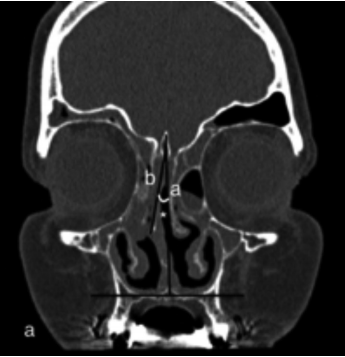Objectives: Pathologies of the frontal recess have an important role in frontal sinus surgery. High nasal septal deviation (NSD) may lead to frontal recess narrowing, and may indirectly affect the surgical success rate. The aim of this study was to identify the potential relationship between high NSD and unsatisfactory frontal sinus surgery.
Methods: Forty-five patients who had undergone revision frontal sinus surgery were included in the study. Paranasal computerised tomographic images obtained prior to the revision surgery, together with operative findings, were retrospectively investigated. High NSD, angulation of the septum, width of the frontal recess, involved sinuses, and other additional abnormalities were noted.
Results: Data from 31 of 45 patients (68.9%) demonstrated pathology in both frontal sinuses, whereas data from 8 (17.8%) and 6 (13.3%) demonstrated pathology only in the left and the right frontal sinuses, respectively. High NSD was observed in 33 (73.8%) patients. No significant relationship was noted between the side of NSD and the affected frontal sinus. No significant relationship was evident between septal deviation and the vertical length of the frontal sinus (p>0.05).
Conclusıon: We identified that high NSD, regardless of which frontal sinus was involved, was the most commonly encountered pathology in patients who underwent revision frontal sinus surgery.



.png)

